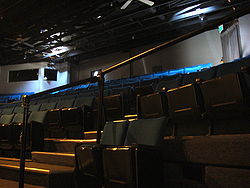
Wharf Theater
Encyclopedia
The Bruce Ariss Wharf Theater as it is officially known today began its history after World War II
when Ariss
, an artist and friend of John Steinbeck
, returned to the city of Monterey after working with his father's construction company.
to Angelo Di Girolamo whose brother had originally proposed the idea of a theatre on Fisherman's Wharf
. Along with Dan Totheroh and Kenn Smith the group located financial backing from two sisters, Virginia and Barbara Blair, who also found the location for the new theatre on the wharf.
Opening night was May 18, 1950, with a production of "Happy Birthday". Ariss designed and built the set. In 1951 Kenn Smith leased the theater to "The Wharf Players, Inc". One of their presentations that year was Bruce Ariss' "Point of Departure". The production was successful enough that MGM brought Ariss to Hollywood, where he worked for the following 5 years.
The theatre expanded and changed hands through the mid to late 1950s. On December 31, 1959, the Wharf Theater was destroyed by a fire, which broke out at 1:31 am.
leveled the location.

The new theatre complex would have an art gallery and an office off the main lobby while on the first floor there would be room for shops. On December 3, 1976, The new Wharf Theater opened its doors with a production of "Guys and Dolls".
World War II
World War II, or the Second World War , was a global conflict lasting from 1939 to 1945, involving most of the world's nations—including all of the great powers—eventually forming two opposing military alliances: the Allies and the Axis...
when Ariss
Bruce Ariss
Bruce Wallace Ariss, Jr. was an American artist and writer.-Life:Bruce Ariss has been influential in Monterey, California, where a street and theatre have been named after him. In addition, he has numerous murals there, at least some of which were 1930s Works Progress Administration projects...
, an artist and friend of John Steinbeck
John Steinbeck
John Ernst Steinbeck, Jr. was an American writer. He is widely known for the Pulitzer Prize-winning novel The Grapes of Wrath and East of Eden and the novella Of Mice and Men...
, returned to the city of Monterey after working with his father's construction company.
The original Wharf Theater
Friend Yanko Varda introduced Bruce ArissBruce Ariss
Bruce Wallace Ariss, Jr. was an American artist and writer.-Life:Bruce Ariss has been influential in Monterey, California, where a street and theatre have been named after him. In addition, he has numerous murals there, at least some of which were 1930s Works Progress Administration projects...
to Angelo Di Girolamo whose brother had originally proposed the idea of a theatre on Fisherman's Wharf
Fisherman's Wharf, Monterey, California
Fisherman's Wharf is a historic wharf in Monterey, California, United States. Used as an active wholesale fish market into the 1960s, the wharf eventually became a tourist attraction as commercial fishing tapered off in the area....
. Along with Dan Totheroh and Kenn Smith the group located financial backing from two sisters, Virginia and Barbara Blair, who also found the location for the new theatre on the wharf.
Opening night was May 18, 1950, with a production of "Happy Birthday". Ariss designed and built the set. In 1951 Kenn Smith leased the theater to "The Wharf Players, Inc". One of their presentations that year was Bruce Ariss' "Point of Departure". The production was successful enough that MGM brought Ariss to Hollywood, where he worked for the following 5 years.
The theatre expanded and changed hands through the mid to late 1950s. On December 31, 1959, the Wharf Theater was destroyed by a fire, which broke out at 1:31 am.
The Old Monterey Opera House
In 1960 the theater re-opened in a newly refurbished location a few blocks from the wharf. Formerly "The Monterey Theater", home of the city's legitimate theatre from 1905 to 1930 and later a movie theater, its first production was "West Side Story". The theatre continued producing shows that featured local talent as well as established theatrical names such as John Kerr, Joe E. Brown, Ethel Waters, Gypsy Rose Lee, Zasu Pitts and Dame Judith Anderson. In 1963 it was renamed "The Old Monterey Opera House", and continued until the mid 1960's when redevelopment and urban renewalUrban renewal
Urban renewal is a program of land redevelopment in areas of moderate to high density urban land use. Renewal has had both successes and failures. Its modern incarnation began in the late 19th century in developed nations and experienced an intense phase in the late 1940s – under the rubric of...
leveled the location.

The new Wharf Theater
After several years the idea of a new Wharf Theater gained momentum again with both Angelo Di Girolamo and Bruce Ariss. The new theatre proposed by Di Girolamo would be on Fisherman's Wharf again, located on a site he owned across from his restaurant. Although originally too small for a theater, the location was enlarged with the purchase of three barracks buildings by Ariss and their use as building material.The new theatre complex would have an art gallery and an office off the main lobby while on the first floor there would be room for shops. On December 3, 1976, The new Wharf Theater opened its doors with a production of "Guys and Dolls".

